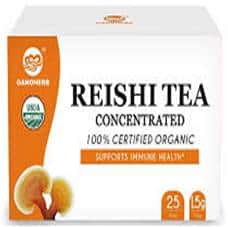Mushrooms and your health
Recently there has been a plethora of products on the market touting the amazing health benefits of mushrooms and extracts made from them. In the class Sandy and I give on mushroom basics we include a slide on the health benefits of eating mushrooms. We felt it was important to let people know they were safe and healthy to eat, especially since the previous slide we show is how some mushrooms can kill you. While I can neither verify not contradict many of the medicinal claims that are being made about mushrooms, there are some basic truths. First, there is a clear distinction between what we call health benefits from eating mushrooms and claims regarding medicinal benefits.

The health benefits from eating mushrooms essentially relate to their nutritional properties in terms of vitamins, minerals, and other healthful compounds they contain. It is estimated that mushrooms generally contain over 17 vitamins and minerals in addition to other compounds like Polysaccharides, which are long chains of carbohydrate molecules with amazing health benefits. There are many studies suggesting that eating mushrooms aid with cardiovascular support, immune system support, reducing inflammation, and aid in fighting cancer. The degree to which these valuable nutrients exist varies between mushrooms species yet all have great nutritional properties.

On the other hand, I have been bewildered by the number of products flooding the market espousing amazing healing properties or just using mushrooms to add value to their product. The picture to the left represents a few of the many products offering extracts of the medicinal mushroom known as Reishi (Ganodermalucidum). The same can be said about Chaga (Inonotus obliquus), Maitake (Grifola frondosa), Shiitake (Lentinula edodes), Turkey Tails (Trametes versicolor), Lion’s Mane (Hericium erinaceus), and Cordyceps (Cordyceps sinensis). Medicinal uses of mushrooms is nothing new since evidence shows the Chinese have been using mushrooms this way for thousands of years. Also, some mushrooms like Reishi, and Turkey Tail are far too tough for culinary use so other means of ingestion are necessary. Sandy and I occasionally harvest Turkey Tails, dry them, grind them up and use the powder for making tea. Given all the amazing compounds contained in mushrooms the mass availability of extracts is not surprising; however, caution is always advised and not all products will have equal benefits. How key compounds are extracted from mushroom sources is an important topic. A study conducted by a University in China in 2014 using different mushroom species and varied extraction methods concluded the following; “The antioxidant activity determination indicated that water extracts and hot water extracts had much higher antioxidant properties than acetone extracts and ethanol extracts. The TPC (Total Phenolic Content) of the samples extracted with water and hot water were also much higher than those extracted with acetone and ethanol.” Additionally, while there is evidence that mushrooms can aid in maintaining a healthy immune system they have not show to be the panacea of all ailments some are espousing.

If popping a pill is not your preferred method of getting your mushroom nutrition you’re in luck. How about mushroom chocolate? I’m not talking about your basic mars bar or almond mounds bar, these are dried mushrooms added to chocolate bars with quite an array of species choices. Or, if you want to make your own bar at home you can buy a readymade blend of four ground up mushrooms and follow the recipe link under references at the end of this article.

Still not happy? I think what you’re really looking forward to is that first cup of mushroom coffee or hot cacao to get your day off to a great start. And, if you’re a teetotaler we have exactly what you have been looking for. Nothing goes better with a big chunk of fungi chocolate than a nice hot cup of Reishi tea. In all honesty, while Sandy and I have not tried the mushroom chocolate, we would if it wasn’t sugar sweetened. On the other hand, we have tried several brands of mushroom tea and quite enjoyed them.

And, if you’re still not satisfied I have no doubt you will come across many other innovative and perhaps slightly strange products infused with one or several mushrooms. Oh yes, while I have not inserted a photo of it, there already is a mushroom bacon on the market. We have not tried it since we like to make our own bacon version. We use thin slices of Lobster mushroom covered with mesquite seasoning and garlic powder, then gently fried to a crispy bacon texture.
Before I end this all things mushroom article I want to discuss one more very important nutritional aspect of eating mushrooms. One of the most important substances contained in mushrooms are amino acids. Meat, fish, and plants all contain amino acids in the form of large, complex molecules which we all know as proteins. These proteins can be made up of thousands of amino acids attached to each other in long chains. For our bodies to take advantage of these amino acids they must first be separated out from the proteins that contain them. Unfortunately, not all food sources contain the complete array of amino acids our bodies need, although this can be easily compensated for by pairing different combinations of food types. Well, where do mushrooms place in the availability of amino acids? I’m glad you asked.
During the International Conference on Agricultural Sciences held in 2019, research results were presented under the heading “Comparison between protein and amino acids of mushroom Agarieus bisporus (our common grocery button mushroom) with some kinds of meat and meat’s products.” The study found that the percentage of protein in the mushroom was higher than all kinds of meat except sheep’s meat and also higher than other products such as eggs, cow’s milk and white, soft cheese made from cow’s milk and sheep’s milk, but it was less than the percentage of protein in the cheese made from sheep’s milk, which contained the highest percentage of protein. The table above summarizes these results

Additionally, mushrooms tested have shown to contain as many as 17 different amino acids included the 9 essential ones our bodies cannot create. As with other nutritional substances found in mushrooms, the amount of each amino acid will vary between mushroom species. That being said, the results of this study are just another reason why mushrooms make a great addition to our diet and to our health.

I may be jumping the gun on this last innovation but new research is showing that mushrooms can also be used as organic substitutes for synthetic nose plugs. How many times have you been out at your local pool or favorite swimming hole and thought how great it would be to have a fully natural way to stop water from creeping up your nose. Now with all natural and most importantly sustainable mushroom nose plugs you can have your wish. They plan to have them in different sizes and colors and are working with purely edible species so after that swim they can still be sautéed in your favorite mushroom dish. The first products may still be a few years away from hitting your store shelves but stay tuned.
As always, stay safe and stay healthy, Ron
References;
Mushroom health benefits – Medicinal News Today
Mushroom Nutrients – Times Magazine
Study of Mushroom Extraction Methods – Austin Publishing Group
Chinese Medicine -MycoSan
Mushroom chocolate bar recipe – Four Sigmatic
Amino Acids Defined – National Library of Medicine
Mushroom protein vs. Meat – protein – Research Gate
Turkey Tail Mushrooms, Identification and Use – Practical Self Reliance





